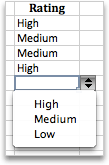Create a drop-down list

Data entry is quicker and more accurate when you restrict values in a cell to choices from a drop-down list.

Start by making a list of valid entries on a sheet, and sort or rearrange the entries so that they appear in the order you want. Then you can use the entries as the source for your drop-down list of data. If the list is not large, you can easily refer to it and type the entries directly into the data validation tool.
-
Create a list of valid entries for the drop-down list, typed on a sheet in a single column or row without blank cells.
-
Select the cells that you want to restrict data entry in.
-
On the Data tab, under Tools , click Data Validation or Validate .

Note: If the validation command is unavailable, the sheet might be protected or the workbook may be shared. You cannot change data validation settings if your workbook is shared or your sheet is protected. For more information about workbook protection, see Protect a workbook .
-
Click the Settings tab, and then in the Allow pop-up menu, click List .
-
Click in the Source box, and then on your sheet, select your list of valid entries.
The dialog box minimizes to make the sheet easier to see.
-
Press RETURN or click the Expand
 button to restore the dialog box, and then click OK .
button to restore the dialog box, and then click OK . Tips:
-
You can also type values directly into the Source box, separated by a comma.
-
To modify the list of valid entries, simply change the values in the source list or edit the range in the Source box.
-
You can specify your own error message to respond to invalid data inputs. On the Data tab, click Data Validation or Validate , and then click the Error Alert tab.
-
See also
Apply data validation to cells
-
In a new worksheet, type the entries you want to appear in your drop-down list. Ideally, you’ll have your list items in an Excel table .
-
Select the cell in the worksheet where you want the drop-down list.
-
Go to the Data tab on the Ribbon, then click Data Validation .
-
On the Settings tab, in the Allow box, click List .
-
If you already made a table with the drop-down entries, click in the Source box, and then click and drag the cells that contain those entries. However, do not include the header cell. Just include the cells that should appear in the drop-down. You can also just type a list of entries in the Source box, separated by a comma like this:
Fruit,Vegetables,Grains,Dairy,Snacks
-
If it’s OK for people to leave the cell empty, check the Ignore blank box.
-
Check the In-cell dropdown box.
-
Click the Input Message tab.
-
If you want a message to pop up when the cell is clicked, check the Show message checkbox, and type a title and message in the boxes (up to 225 characters). If you don’t want a message to show up, clear the check box.
-
-
Click the Error Alert tab.
-
If you want a message to pop up when someone enters something that’s not in your list, check the Show Alert checkbox, pick an option in Type , and type a title and message. If you don’t want a message to show up, clear the check box.
-
-
Click OK .
After you create your drop-down list, make sure it works the way you want. For example, you might want to check to see if Change the column width and row height to show all your entries. If you decide you want to change the options in your drop-down list, see Add or remove items from a drop-down list . To delete a drop-down list, see Remove a drop-down list .

Create a drop-down list
You can insert a drop-down list of valid entries (also called a drop-down menu or drop-down box) in Excel to make data entry easier, or to limit entries to certain items that you define.
If you have any question please CONTACT Us Email us at: infohouston@macco.com Call US :(936) 588-1888
Don’t Forget to Visit our Services





